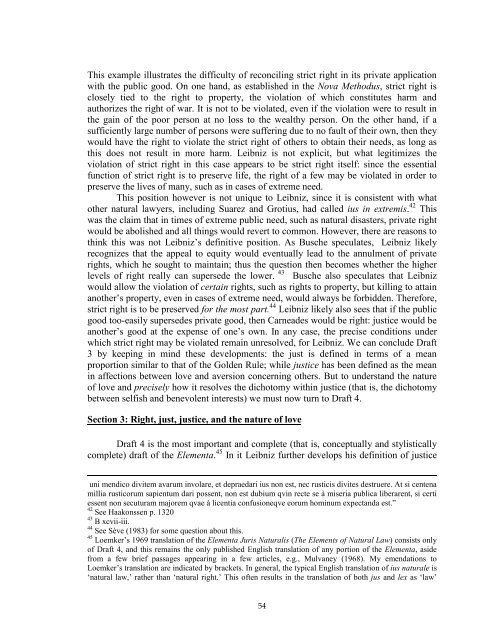Stony Brook University
Stony Brook University
Stony Brook University
You also want an ePaper? Increase the reach of your titles
YUMPU automatically turns print PDFs into web optimized ePapers that Google loves.
This example illustrates the difficulty of reconciling strict right in its private application<br />
with the public good. On one hand, as established in the Nova Methodus, strict right is<br />
closely tied to the right to property, the violation of which constitutes harm and<br />
authorizes the right of war. It is not to be violated, even if the violation were to result in<br />
the gain of the poor person at no loss to the wealthy person. On the other hand, if a<br />
sufficiently large number of persons were suffering due to no fault of their own, then they<br />
would have the right to violate the strict right of others to obtain their needs, as long as<br />
this does not result in more harm. Leibniz is not explicit, but what legitimizes the<br />
violation of strict right in this case appears to be strict right itself: since the essential<br />
function of strict right is to preserve life, the right of a few may be violated in order to<br />
preserve the lives of many, such as in cases of extreme need.<br />
This position however is not unique to Leibniz, since it is consistent with what<br />
other natural lawyers, including Suarez and Grotius, had called ius in extremis. 42 This<br />
was the claim that in times of extreme public need, such as natural disasters, private right<br />
would be abolished and all things would revert to common. However, there are reasons to<br />
think this was not Leibniz’s definitive position. As Busche speculates, Leibniz likely<br />
recognizes that the appeal to equity would eventually lead to the annulment of private<br />
rights, which he sought to maintain; thus the question then becomes whether the higher<br />
levels of right really can supersede the lower. 43 Busche also speculates that Leibniz<br />
would allow the violation of certain rights, such as rights to property, but killing to attain<br />
another’s property, even in cases of extreme need, would always be forbidden. Therefore,<br />
strict right is to be preserved for the most part. 44 Leibniz likely also sees that if the public<br />
good too-easily supersedes private good, then Carneades would be right: justice would be<br />
another’s good at the expense of one’s own. In any case, the precise conditions under<br />
which strict right may be violated remain unresolved, for Leibniz. We can conclude Draft<br />
3 by keeping in mind these developments: the just is defined in terms of a mean<br />
proportion similar to that of the Golden Rule; while justice has been defined as the mean<br />
in affections between love and aversion concerning others. But to understand the nature<br />
of love and precisely how it resolves the dichotomy within justice (that is, the dichotomy<br />
between selfish and benevolent interests) we must now turn to Draft 4.<br />
Section 3: Right, just, justice, and the nature of love<br />
Draft 4 is the most important and complete (that is, conceptually and stylistically<br />
complete) draft of the Elementa. 45 In it Leibniz further develops his definition of justice<br />
uni mendico divitem avarum involare, et depraedari ius non est, nec rusticis divites destruere. At si centena<br />
millia rusticorum sapientum dari possent, non est dubium qvin recte se à miseria publica liberarent, si certi<br />
essent non secuturam majorem qvae à licentia confusioneqve eorum hominum expectanda est.”<br />
42<br />
See Haakonssen p. 1320<br />
43<br />
B xcvii-iii.<br />
44<br />
See Sève (1983) for some question about this.<br />
45<br />
Loemker’s 1969 translation of the Elementa Juris Naturalis (The Elements of Natural Law) consists only<br />
of Draft 4, and this remains the only published English translation of any portion of the Elementa, aside<br />
from a few brief passages appearing in a few articles, e.g., Mulvaney (1968). My emendations to<br />
Loemker’s translation are indicated by brackets. In general, the typical English translation of ius naturale is<br />
‘natural law,’ rather than ‘natural right.’ This often results in the translation of both jus and lex as ‘law’<br />
54
















